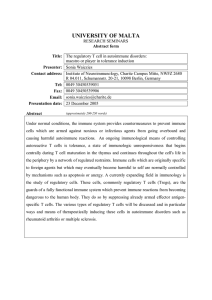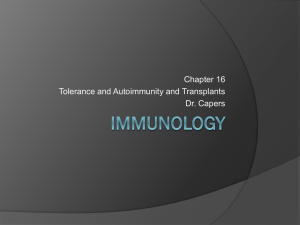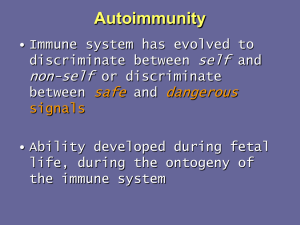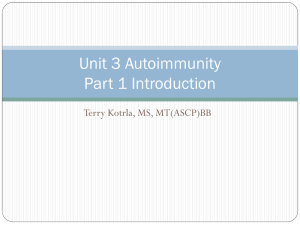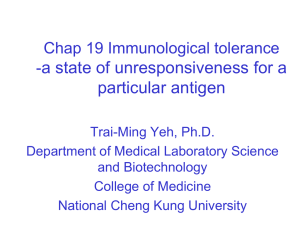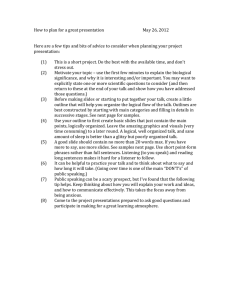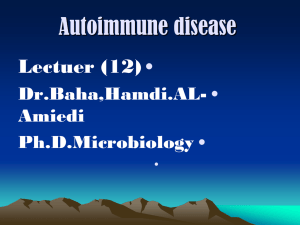Document 13309942
advertisement
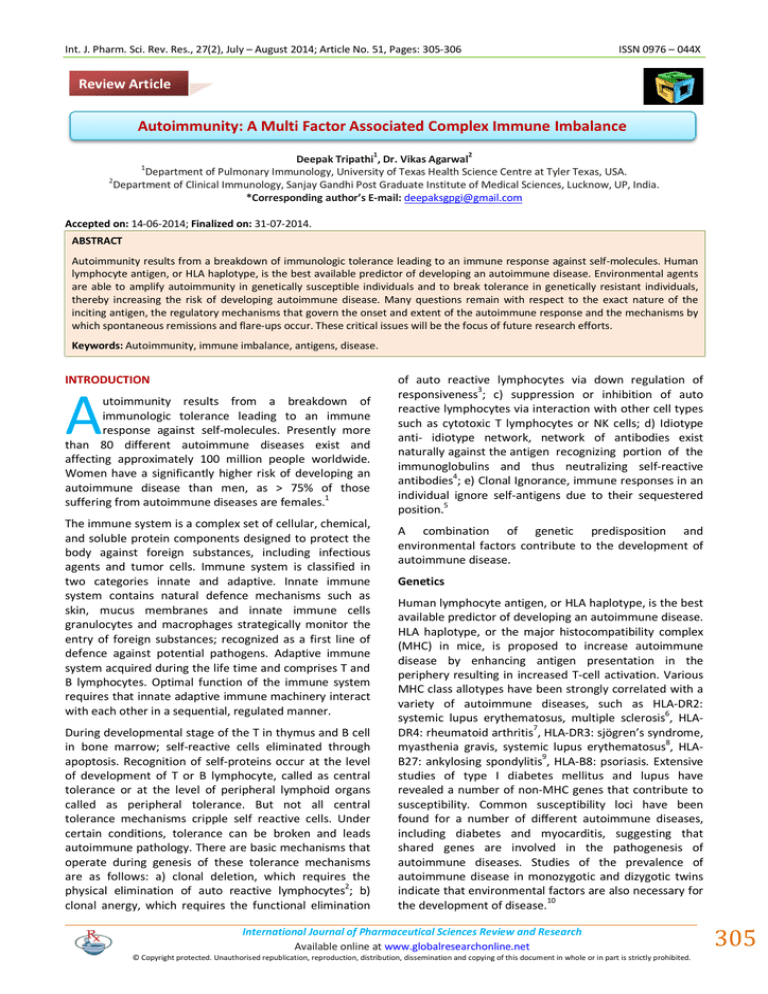
Int. J. Pharm. Sci. Rev. Res., 27(2), July – August 2014; Article No. 51, Pages: 305-306 ISSN 0976 – 044X Review Article Autoimmunity: A Multi Factor Associated Complex Immune Imbalance 1 2 Deepak Tripathi , Dr. Vikas Agarwal Department of Pulmonary Immunology, University of Texas Health Science Centre at Tyler Texas, USA. 2 Department of Clinical Immunology, Sanjay Gandhi Post Graduate Institute of Medical Sciences, Lucknow, UP, India. *Corresponding author’s E-mail: deepaksgpgi@gmail.com 1 Accepted on: 14-06-2014; Finalized on: 31-07-2014. ABSTRACT Autoimmunity results from a breakdown of immunologic tolerance leading to an immune response against self-molecules. Human lymphocyte antigen, or HLA haplotype, is the best available predictor of developing an autoimmune disease. Environmental agents are able to amplify autoimmunity in genetically susceptible individuals and to break tolerance in genetically resistant individuals, thereby increasing the risk of developing autoimmune disease. Many questions remain with respect to the exact nature of the inciting antigen, the regulatory mechanisms that govern the onset and extent of the autoimmune response and the mechanisms by which spontaneous remissions and flare-ups occur. These critical issues will be the focus of future research efforts. Keywords: Autoimmunity, immune imbalance, antigens, disease. INTRODUCTION A utoimmunity results from a breakdown of immunologic tolerance leading to an immune response against self-molecules. Presently more than 80 different autoimmune diseases exist and affecting approximately 100 million people worldwide. Women have a significantly higher risk of developing an autoimmune disease than men, as > 75% of those suffering from autoimmune diseases are females.1 The immune system is a complex set of cellular, chemical, and soluble protein components designed to protect the body against foreign substances, including infectious agents and tumor cells. Immune system is classified in two categories innate and adaptive. Innate immune system contains natural defence mechanisms such as skin, mucus membranes and innate immune cells granulocytes and macrophages strategically monitor the entry of foreign substances; recognized as a first line of defence against potential pathogens. Adaptive immune system acquired during the life time and comprises T and B lymphocytes. Optimal function of the immune system requires that innate adaptive immune machinery interact with each other in a sequential, regulated manner. During developmental stage of the T in thymus and B cell in bone marrow; self-reactive cells eliminated through apoptosis. Recognition of self-proteins occur at the level of development of T or B lymphocyte, called as central tolerance or at the level of peripheral lymphoid organs called as peripheral tolerance. But not all central tolerance mechanisms cripple self reactive cells. Under certain conditions, tolerance can be broken and leads autoimmune pathology. There are basic mechanisms that operate during genesis of these tolerance mechanisms are as follows: a) clonal deletion, which requires the physical elimination of auto reactive lymphocytes2; b) clonal anergy, which requires the functional elimination of auto reactive lymphocytes via down regulation of responsiveness3; c) suppression or inhibition of auto reactive lymphocytes via interaction with other cell types such as cytotoxic T lymphocytes or NK cells; d) Idiotype anti- idiotype network, network of antibodies exist naturally against the antigen recognizing portion of the immunoglobulins and thus neutralizing self-reactive antibodies4; e) Clonal Ignorance, immune responses in an individual ignore self-antigens due to their sequestered position.5 A combination of genetic predisposition and environmental factors contribute to the development of autoimmune disease. Genetics Human lymphocyte antigen, or HLA haplotype, is the best available predictor of developing an autoimmune disease. HLA haplotype, or the major histocompatibility complex (MHC) in mice, is proposed to increase autoimmune disease by enhancing antigen presentation in the periphery resulting in increased T-cell activation. Various MHC class allotypes have been strongly correlated with a variety of autoimmune diseases, such as HLA-DR2: 6 systemic lupus erythematosus, multiple sclerosis , HLA7 DR4: rheumatoid arthritis , HLA-DR3: sjögren’s syndrome, myasthenia gravis, systemic lupus erythematosus8, HLAB27: ankylosing spondylitis9, HLA-B8: psoriasis. Extensive studies of type I diabetes mellitus and lupus have revealed a number of non-MHC genes that contribute to susceptibility. Common susceptibility loci have been found for a number of different autoimmune diseases, including diabetes and myocarditis, suggesting that shared genes are involved in the pathogenesis of autoimmune diseases. Studies of the prevalence of autoimmune disease in monozygotic and dizygotic twins indicate that environmental factors are also necessary for the development of disease.10 International Journal of Pharmaceutical Sciences Review and Research Available online at www.globalresearchonline.net © Copyright protected. Unauthorised republication, reproduction, distribution, dissemination and copying of this document in whole or in part is strictly prohibited. 305 Int. J. Pharm. Sci. Rev. Res., 27(2), July – August 2014; Article No. 51, Pages: 305-306 Environment Environmental agents are able to amplify autoimmunity in genetically susceptible individuals and to break tolerance in genetically resistant individuals, thereby increasing the risk of developing autoimmune disease. Hormones Sex hormones can directly interact with cells of the immune system via receptors on the surface or inside immune cells. Steroid hormones, including estrogens and androgens, are known to influence antibody production and immune cell proliferation. Excessive secretion of hormones or high expression of receptor leads the autoimmunity predominantly in females. Exposure of isolated antigens T cells specific to self antigens not present in the thymus during the early stage of T cell development may escape from thymic deletion. These self antigens (cryptic/hidden) generally have relatively low circulating levels or anatomically sequestered in specific tissues. Tissue trauma and infection with tissue-tropic pathogens such viruses lead to tissue damage that results in the exposed the isolated antigen to the self reactive T cells.11 Altered Self Peptide Chemical alteration or drug induced modification in self peptide can also induce the autoimmunity. Some metals induce autoimmune disease via the creation of new highaffinity binding sites for MHC molecules on chemical bound self peptides and allow activation of previously anergized T cells. (IL-12, IFN-γ) and Th17 (IL-17) are proinflammatory cytokines that cause intense inflammation and tissue damage whereas Th2 (IL-4, IL-10, TGF-β) are antiinflammatory cytokines that keep the inflammation in check. Any imbalance between the two will predispose the host towards autoimmunity. Many questions remain with respect to the exact nature of the inciting antigen, the regulatory mechanisms that govern the onset and extent of the autoimmune response and the mechanisms by which spontaneous remissions and flare-ups occur. These critical issues will be the focus of future research efforts. REFERENCES 1. Jacobson. Epidemiology and estimated population burden of selected autoimmune disease in the United States. Clin Immunol Immunopathol, 84, 1997, 223-243. 2. Venanzi ES, Benoist C, Mathis D. Good riddance: thymocytes clonal deletion prevents autoimmunity. Curr Opin Immunol, 16, 2004, 197–202. 3. Pike BL, Boyd AW, Nossal G. Clonal anergy: the universally anergic B lymphocyte. Proc Natl Acad Sci USA, 79, 1982, 2013. 4. Jerne NK. Towards a network theory of the immune system. Ann Immunol, 125C(1–2), 1974, 373–89. 5. Mackay IR, Rosen FS, Kamradt T, Mitchison NA. Tolerance and autoimmunity. New Eng J Med, 344, 2001, 655–64. 6. Klein J. The HLA system. Second of two parts. N Engl J Med, 343, 2000, 782–6. 7. Wordsworth B, Lanchbury J, Sakkas L, Welsh K, Panayi G, Bell J. HLA-DR4 subtype frequencies in rheumatoid arthritis indicate that DRB1 is the major susceptibility locus within the HLA class II region. Proc Natl Acad Sci USA, 86, 1989, 10049. 8. Fox R, Kang H. Pathogenesis of Sjögren’s syndrome. Rheum Dis Clin N Am, 18, 1992, 517. 9. Van der Linden S, Valkenburg H, De Jongh B, Cats A. The risk of developing ankylosing spondylitis in HLA-B27 positive individuals. A comparison of relatives of spondylitis patients with the general population. Arthritis Rheum, 27, 1984, 241–9. Molecular Mimicry Molecular mimicry of many exogenous antigens with the host protein induces organ specific autoimmune response. Immune response directed against the foreign antigen can damage the host tissues and thus leads to autoimmunity. Strong clinical and epidemiological evidences support the molecular mimicry hypothesis for several autoimmune diseases like insulin-dependent diabetes, multiple sclerosis, and HLA-B27-associated ankylosing spondylitis.12 Polyclonal Activators Exogenous polyclonal activators may mutually stimulate T cells that react with the MHC class II super antigens on B cells promote cytokine overproduction and the B cells themselves, leading to the production to polyclonal Ig.13 Cytokine dysregulation Immune response generates cytokines that mediate the tissue damage and inflammation. There are different categories of cytokines, namely Th1, Th17 and Th2. Th1 ISSN 0976 – 044X 10. Dang MN, Buzzetti R, Pozzilli P.Epigenetics in autoimmune diseases with focus on type 1 diabetes. Diabetes Metab Res Rev., 29(1), 2013, 8-18. 11. A M Ercolini and S D Miller. The role of infections in autoimmune disease. Clin Exp Immunol., 155(1), 2009, 1– 15. 12. M. B. A. Oldstone. Molecular Mimicry, Microbial Infection, and Autoimmune Disease: Evolution of the Concept. Current Topics in Microbiology and Immunology., 296, 2005, 1-17. 13. D M Bucholz, S Dray, and M Teodorescu. Dependence of lymphocyte surface Ig on continuous polyclonal activation. Immunology., 37(4), 1979, 731–742. Source of Support: Nil, Conflict of Interest: None. International Journal of Pharmaceutical Sciences Review and Research Available online at www.globalresearchonline.net © Copyright protected. Unauthorised republication, reproduction, distribution, dissemination and copying of this document in whole or in part is strictly prohibited. 306
